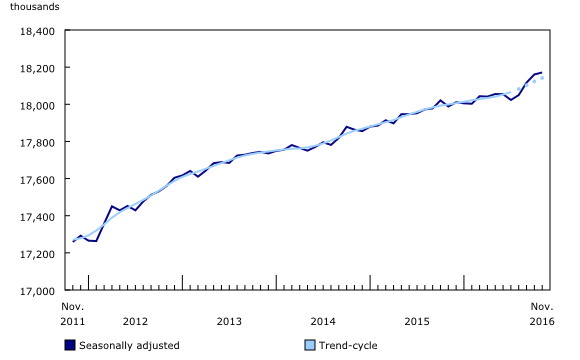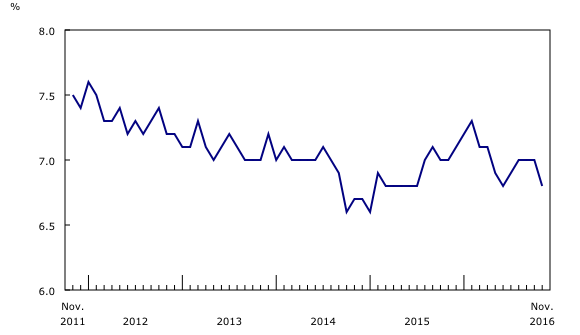Labour Force Survey, November 2016
Archived Content
Information identified as archived is provided for reference, research or recordkeeping purposes. It is not subject to the Government of Canada Web Standards and has not been altered or updated since it was archived. Please "contact us" to request a format other than those available.
Released: 2016-12-02
After two consecutive months of notable increases, employment was little changed in November (+11,000 or +0.1%). With fewer people searching for work, the unemployment rate fell by 0.2 percentage points to 6.8%.
Compared with November 2015, overall employment rose by 183,000 (+1.0%), with the number of people working part time increasing by 214,000 (+6.4%). Over the same period, the total number of hours worked was up 1.1%.
Highlights
In November, employment increased for men in the 25 to 54 age group and for men 55 and older, while it declined for women 55 and older. There was little change among the other demographic groups.
Provincially, employment rose in Nova Scotia while it fell in Alberta.
More people were employed in the finance, insurance, real estate and leasing industry, in information, culture and recreation, in the "other services" industry and in agriculture. On the other hand, declines were observed in construction, in manufacturing, as well as in transportation and warehousing.
There were fewer self-employed workers in November, while the number of employees was little changed in both the public and private sectors.
Demographic overview
Employment rose by 22,000 among men aged 25 to 54 in November, and their unemployment rate was 6.3%. Compared with 12 months earlier, employment for men in this age group was little changed.
For men 55 and older, employment increased by 13,000, lowering their unemployment rate by 0.7 percentage points to 6.6%. On a year-over-year basis, employment for this group was up 47,000 (+2.3%) and their unemployment rate was unchanged.
Among women 55 and older, employment fell by 19,000 in November and the unemployment rate was 4.7%. In the 12 months to November, employment for women in this age group was up 80,000 or 4.8%—the largest employment growth of all demographic groups.
While little changed in the month, employment for women 25 to 54 was up 54,000 (+1.0%) on a year-over-year basis. At the same time, their unemployment rate declined by 0.6 percentage points to 5.2%.
Youth aged 15 to 24 saw little change in employment both on a monthly and year-over-year basis, while their population growth continued on a downward trend. The youth unemployment rate stood at 12.9% in November.
Provincial summary
In Nova Scotia, 3,700 more people were employed in November and the unemployment rate was 8.0%. On a year-over-year basis, employment in the province was virtually unchanged.
In Alberta, employment fell by 13,000 in November. At the same time, the number of job-seekers increased (+11,000), pushing the unemployment rate up 0.5 percentage points to 9.0%—the highest rate since July 1994. Compared with November 2015, employment in the province was down 30,000 (-1.3%) and unemployment increased by 52,000 (+30.6%).
Employment in Ontario edged up in November (+19,000 or +0.3%), following a notable increase the previous month. The unemployment rate was little changed at 6.3% in November. Compared with 12 months earlier, employment in the province grew by 105,000 (+1.5%).
British Columbia saw little change in the number of employed in November. Compared with 12 months earlier, employment gains totalled 48,000 or 2.1%—the fastest growth rate among the provinces. Though little changed in the month, British Columbia's unemployment rate remained the lowest provincially at 6.1%.
Employment in Quebec was also little changed in November. With fewer job-seekers, Quebec's unemployment rate fell 0.6 percentage points to 6.2%—a record low since comparable data became available in 1976—continuing a downward trend since the beginning of 2016. On a year-over-year basis, employment in the province increased by 81,000 (+2.0%) and unemployment declined by 56,000 (-17.0%).
Industry perspective
In November, 14,000 more people worked in finance, insurance, real estate and leasing, bringing employment gains in this industry to 51,000 (+4.7%) on a year-over-year basis. Employment in this industry has been on an upward trend since the end of 2015.
Employment rose by 13,000 in information, culture and recreation, contributing to a 12-month total increase of 45,000, or 5.9%—the largest rate of growth of all industries on a year-over-year basis. Employment in information, culture and recreation has been trending up since the spring of 2015.
In the "other services" industry, employment increased for the second consecutive month, up 11,000 in November. "Other services" include services related to civic and professional organizations, private households, repair and maintenance as well as personal and laundry services. On a year-over-year basis, employment in this industry was up 39,000 (+5.1%).
Employment also increased in agriculture, up 6,000 in November. On a year-over-year basis, however, employment in this industry was down 15,000 (-4.9%).
On the other hand, employment in construction fell by 14,000 in November, partly offsetting the increase observed in the previous month. Most of the decline was accounted for by Alberta and Quebec. Compared with 12 months earlier, national employment in construction was little changed.
Employment also fell in manufacturing, down 12,000 in November, bringing year-over-year losses in the industry to 50,000 (-2.9%).
In transportation and warehousing, employment was down 9,700 in the month and little changed on a year-over-year basis.
There were 31,000 fewer self-employed workers in November, while the number of employees was little changed in both the public and private sectors. Compared with November 2015, the number of private sector employees increased by 172,000 (+1.5%), while there was little change for public sector employees and self-employed workers.
Note to readers
Upcoming revisions
A standard revision to the Labour Force Survey (LFS) data will be released on February 3, 2017. The LFS seasonally adjusted estimates available in CANSIM will be revised back to January 2014 using updated seasonal factors.
Beginning with the release of January 2017 data on February 10, occupation data will be based on the 2016 National Occupational Classification (NOC). Because NOC 2016 maintains the NOC 2011 structure of major, minor and unit groups, no historical revision of data is necessary.
The LFS estimates for November are for the week of November 6 to 12.
The LFS estimates are based on a sample and are therefore subject to sampling variability. As a result, monthly estimates will show more variability than trends observed over longer time periods. For more information, see "Interpreting Monthly Changes in Employment from the Labour Force Survey." Estimates for smaller geographic areas or industries also have more variability. For an explanation of the sampling variability of estimates and how to use standard errors to assess this variability, consult the "Data quality" section of the publication Labour Force Information (71-001-X).
This analysis focuses on differences between estimates that are statistically significant at the 68% confidence level.
The LFS estimates are the first in a series of labour market indicators released by Statistics Canada, which includes indicators from programs such as the Survey of Payroll Employment, Earnings and Hours (SEPH), Employment Insurance Statistics, and the Job Vacancy and Wage Survey. For more information on the conceptual differences between employment measures from the LFS and SEPH, refer to section 8 of the Guide to the Labour Force Survey (71-543-G).
The employment rate is the number of employed people as a percentage of the population aged 15 and older. The rate for a particular group (for example, youths aged 15 to 24) is the number employed in that group as a percentage of the population for that group.
The unemployment rate is the number of unemployed as a percentage of the labour force (employed and unemployed).
The participation rate is the number of employed and unemployed as a percentage of the population.
Seasonal adjustment
Unless otherwise stated, this release presents seasonally adjusted estimates, which facilitate comparisons by removing the effects of seasonal variations. For more information on seasonal adjustment, see Seasonally adjusted data – Frequently asked questions.
Chart 1 shows trend-cycle data on employment. These data represent a smoothed version of the seasonally adjusted time series, which provides information on longer-term movements, including changes in direction underlying the series. These data are available in CANSIM table 282-0087 for the national level employment series. For more information, see the StatCan Blog and Trend-cycle estimates – Frequently asked questions.
Next release
The next release of the LFS will be on January 6, 2017. Since this release will cover December data, a year-end review will be included.
Products
A more detailed summary, Labour Force Information (71-001-X), is now available for the week ending November 12.
More information about the concepts and use of the Labour Force Survey is available online in the Guide to the Labour Force Survey (71-543-G).
For information on the impact of the northern Alberta wildfires on hours worked, see the report released in The Daily.
Contact information
For more information, contact us (toll-free 1-800-263-1136; 514-283-8300; STATCAN.infostats-infostats.STATCAN@canada.ca).
To enquire about the concepts, methods or data quality of this release, contact Andrew Fields (613-951-3551; andrew.fields@canada.ca) or Lahouaria Yssaad (613-951-0627; lahouaria.yssaad@canada.ca), Labour Statistics Division.
- Date modified:





